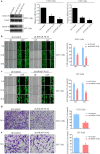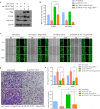SWAP-70 promotes glioblastoma cellular migration and invasion by regulating the expression of CD44s
- PMID: 31832018
- PMCID: PMC6873484
- DOI: 10.1186/s12935-019-1035-3
SWAP-70 promotes glioblastoma cellular migration and invasion by regulating the expression of CD44s
Abstract
Background: Switch-associated protein 70 (SWAP-70) is a guanine nucleotide exchange factor that is involved in cytoskeletal rearrangement and regulation of migration and invasion of malignant tumors. However, the mechanism by which SWAP-70 regulates the migration and invasion of glioblastoma (GB) cells has not been fully elucidated.
Methods: This study used an online database to analyze the relationship between SWAP-70 expression and prognosis in GB patients. The in vitro wound healing assay and transwell invasion assay were used to determine the role of SWAP-70 in GB cell migration and invasion as well as the underlying mechanism.
Results: We found that patients with high SWAP-70 expression in the GB had a poor prognosis. Downregulation of SWAP-70 inhibited GB cell migration and invasion, whereas SWAP-70 overexpression had an opposite effect. Interestingly, SWAP-70 expression was positively correlated with the expression of the standard form of CD44 (CD44s) in GB tissues. Downregulation of SWAP-70 also reduced CD44s protein expression, whereas SWAP-70 overexpression enhanced CD44s protein expression. However, downregulation of SWAP-70 expression did not affect the mRNA expression of CD44s. Reversal experiments showed that overexpressing CD44s in cell lines with downregulated SWAP-70 partially abolished the inhibitory effects of downregulated SWAP-70 on GB cell migration and invasion.
Conclusions: These results suggest that SWAP-70 may promote GB cell migration and invasion by regulating the expression of CD44s. SWAP-70 may serve as a new biomarker and a potential therapeutic target for GB.
Keywords: CD44s; Glioblastoma; Invasion; Migration; SWAP-70.
© The Author(s) 2019.
Conflict of interest statement
Competing interestsThe authors declare that they have no competing interests.
Figures





Similar articles
-
Tunicamycin inhibits cell proliferation and migration in hepatocellular carcinoma through suppression of CD44s and the ERK1/2 pathway.Cancer Sci. 2018 Apr;109(4):1088-1100. doi: 10.1111/cas.13518. Epub 2018 Feb 26. Cancer Sci. 2018. PMID: 29377347 Free PMC article.
-
The Src homology 3 domain-containing guanine nucleotide exchange factor is overexpressed in high-grade gliomas and promotes tumor necrosis factor-like weak inducer of apoptosis-fibroblast growth factor-inducible 14-induced cell migration and invasion via tumor necrosis factor receptor-associated factor 2.J Biol Chem. 2013 Jul 26;288(30):21887-97. doi: 10.1074/jbc.M113.468686. Epub 2013 Jun 17. J Biol Chem. 2013. PMID: 23775076 Free PMC article.
-
HnRNPM and CD44s expression affects tumor aggressiveness and predicts poor prognosis in breast cancer with axillary lymph node metastases.Genes Chromosomes Cancer. 2017 Aug;56(8):598-607. doi: 10.1002/gcc.22463. Epub 2017 May 4. Genes Chromosomes Cancer. 2017. PMID: 28393427
-
The distribution of extracellular matrix proteins and CD44S expression in human astrocytomas.Pathol Oncol Res. 2000;6(2):118-24. doi: 10.1007/BF03032361. Pathol Oncol Res. 2000. PMID: 10936787
-
Implications of Rho GTPase Signaling in Glioma Cell Invasion and Tumor Progression.Front Oncol. 2013 Oct 4;3:241. doi: 10.3389/fonc.2013.00241. Front Oncol. 2013. PMID: 24109588 Free PMC article. Review.
Cited by
-
Proteomic Profiles Associated With Postsurgical Progression in Nonfunctioning Pituitary Adenomas.J Clin Endocrinol Metab. 2024 May 17;109(6):1485-1493. doi: 10.1210/clinem/dgad767. J Clin Endocrinol Metab. 2024. PMID: 38157275 Free PMC article.
-
The Role of Rho GTPases in Motility and Invasion of Glioblastoma Cells.Anal Cell Pathol (Amst). 2020 Jan 31;2020:9274016. doi: 10.1155/2020/9274016. eCollection 2020. Anal Cell Pathol (Amst). 2020. PMID: 32089990 Free PMC article. Review.
-
SWAP70 Overexpression Protects Against Pathological Cardiac Hypertrophy in a TAK1-Dependent Manner.J Am Heart Assoc. 2023 Apr 4;12(7):e028628. doi: 10.1161/JAHA.122.028628. Epub 2023 Mar 28. J Am Heart Assoc. 2023. PMID: 36974751 Free PMC article.
-
The genes significantly associated with an improved prognosis and long-term survival of glioblastoma.PLoS One. 2023 Nov 29;18(11):e0295061. doi: 10.1371/journal.pone.0295061. eCollection 2023. PLoS One. 2023. PMID: 38019838 Free PMC article.
-
Affinity purification mass spectrometry characterisation of the interactome of receptor tyrosine kinase proline-rich motifs in cancer.Heliyon. 2024 Jul 31;10(15):e35480. doi: 10.1016/j.heliyon.2024.e35480. eCollection 2024 Aug 15. Heliyon. 2024. PMID: 39165974 Free PMC article.
References
LinkOut - more resources
Full Text Sources
Miscellaneous

